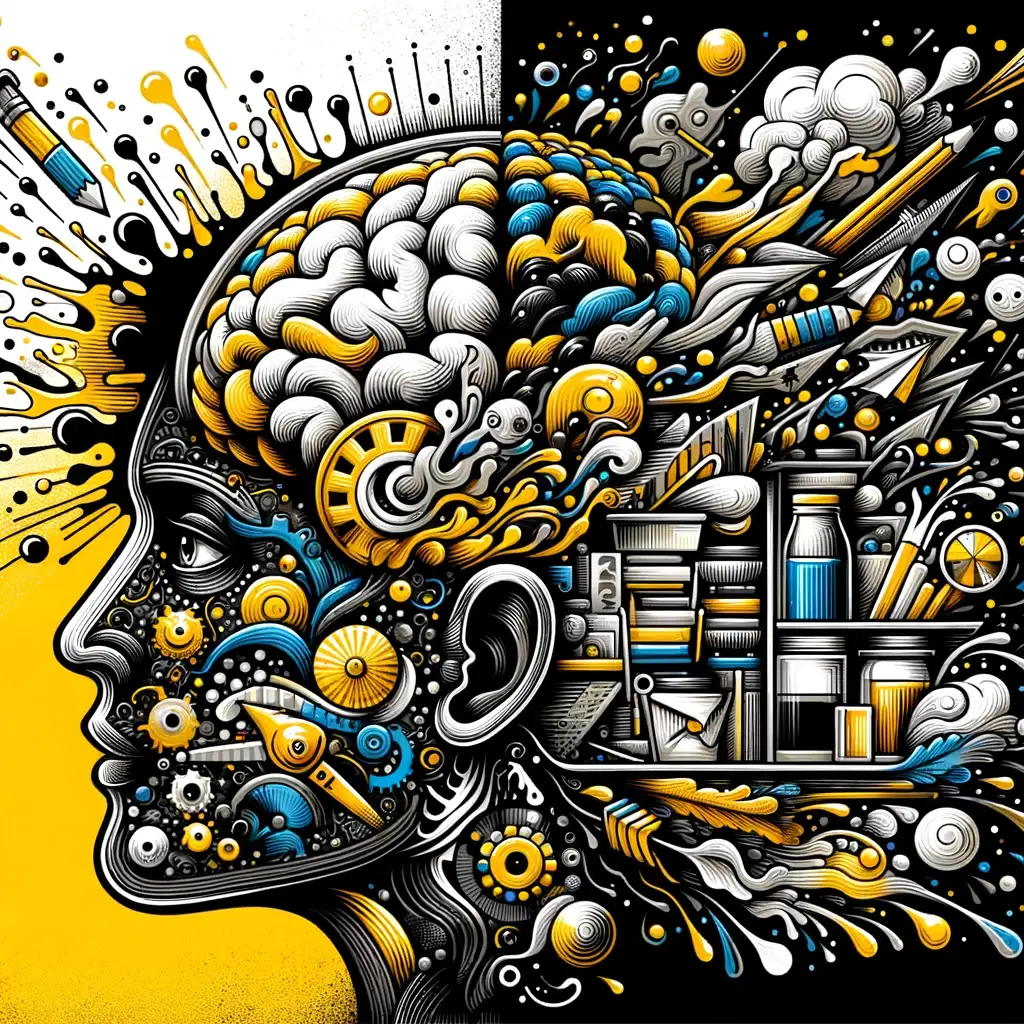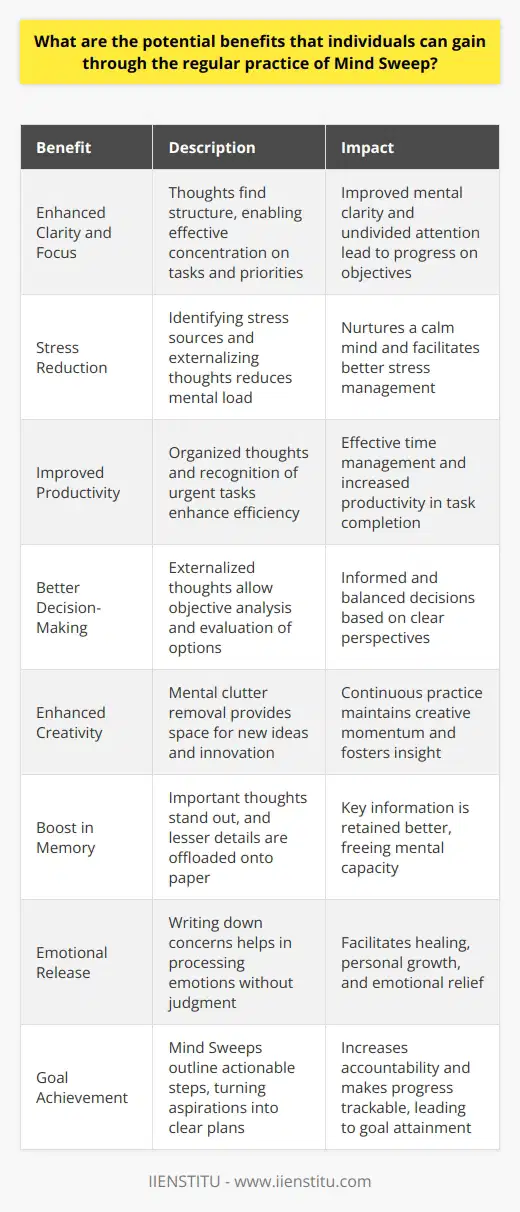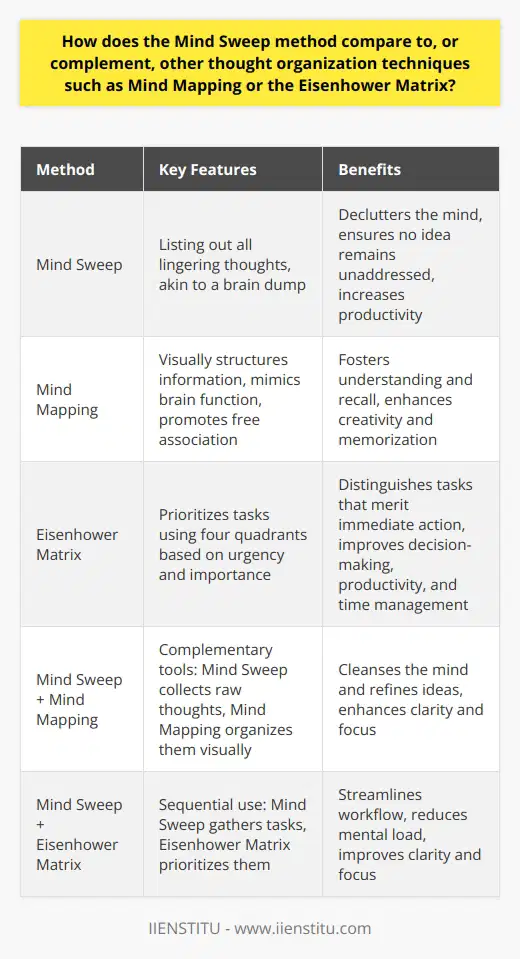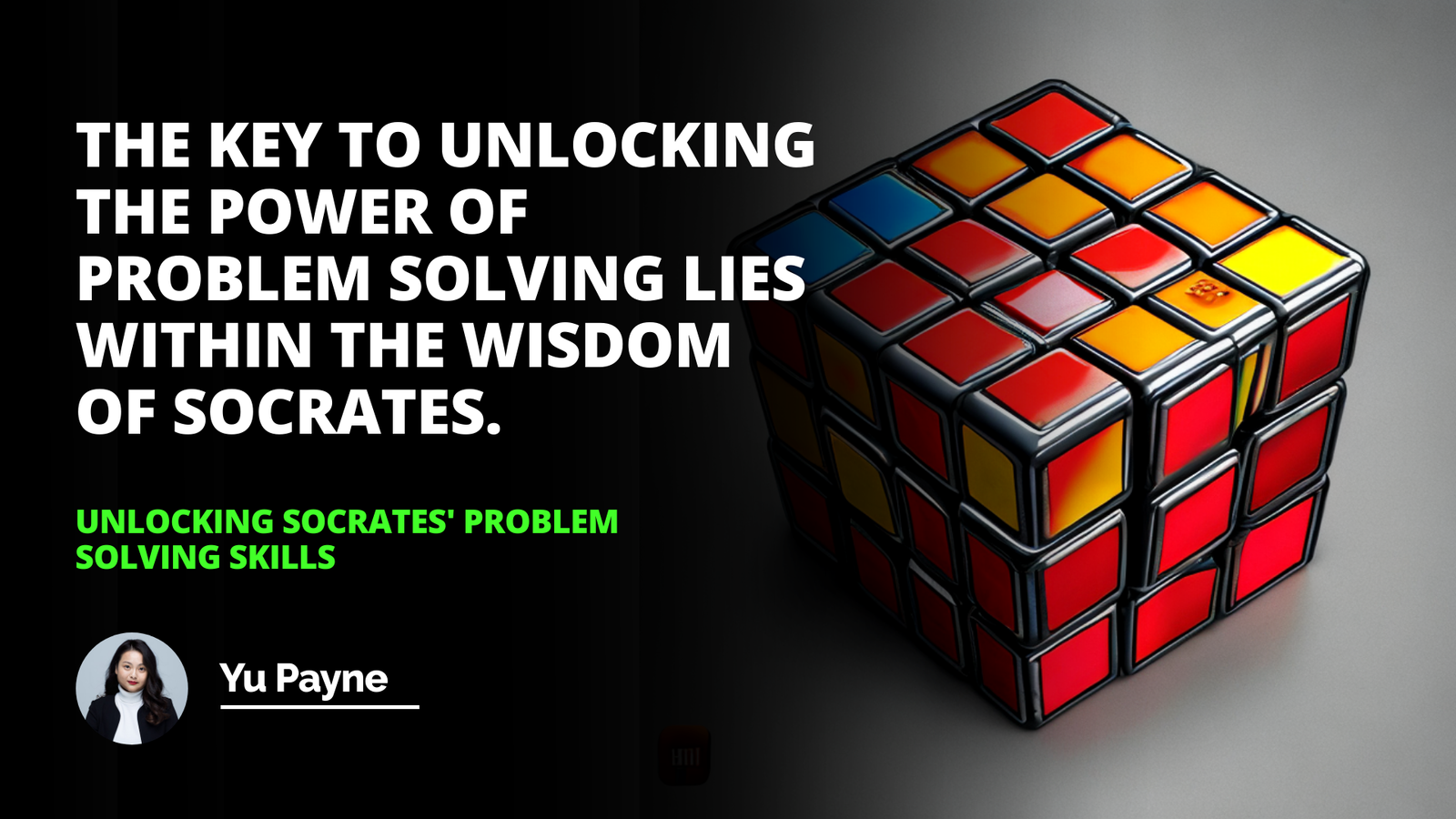
In a world where the constant influx of information is the norm, our minds can often feel inundated with thoughts and ideas, leading to a sense of overwhelming mental clutter. It is in these moments that a technique known as a Mind Sweep can act as an intellectual panacea, organizing our thoughts and alleviating the mental fog.
Mind Sweeps have become essential not only for personal productivity but also for maintaining mental well-being in everyday life. This blog will delve into the mechanics of a Mind Sweep, illustrating its importance and offering a step-by-step guide for those looking to optimize their mental landscape. By understanding and applying this technique, readers can expect to unravel the tangled web of their thoughts and sharpen their focus for clearer thought processes.
The Theory Behind Mind Sweep
Effects of Stress and Information Overload on Mental Health
The rise of the digital age has been a harbinger of increased stress and information overload, impinging on mental health and cognitive capabilities. Mental clutter can lead to difficulty in concentrating, a decrease in productivity, and may compound stress-related issues. A cluttered mind can resemble an overstuffed closet where nothing can be found—it stifles our ability to think and operate effectively.

The Role of Mindfulness in Reducing Mental Clutter
In reaction to these modern maladies, mindfulness practices have surged in popularity, promoting techniques that render clarity and peace. A Mind Sweep can be viewed as an act of mindfulness, as it requires one's full attention and consciousness to categorize and acknowledge each thought. This practice aligns closely with meditative exercises which aim to declutter the mind and restore a sense of calm.

Origins and Evolution of the Mind Sweep Concept
The concept of Mind Sweep has been gestating within productivity and personal development literature for years. Credited thought leaders, such as David Allen, have advocated for this method as part of a more extensive system of personal organization. The process involves cataloging thoughts, ideas, and tasks in an external system, which, in turn, frees the mind from the burden of constant recall and reorganization.

The Process of Mind Sweep
Preparation and Mindset Required for a Successful Mind Sweep
Before one begins a Mind Sweep, ensuring that you are in a conducive environment with minimal distractions is crucial. The mindset entering this process should be one of non-judgment; allow each thought to surface without criticism or immediate analysis. This frame of mind supports a more thorough and decluttered mental inventory.

Instructions for Conducting the Actual Procedure
Performing a Mind Sweep begins with gathering a writing implement and notepad, or a digital tool of choice, then simply writing down every thought, task, idea, or concern that comes to mind. The aim is to externalize the contents of your mental landscape without filtering or organizing them at this stage.

Tools and Aids that Can Enhance the Process
To optimize your Mind Sweep, employing tools such as digital organizing applications or designated notebooks can ease the transfer of thoughts. Utilizing categories and color-coding during later organization stages can also aid in the visual compartmentalization of different kinds of thoughts.

Benefits of Regular Mind Sweeps
Improvements in Mood and Reduced Stress Levels
Scientific studies have highlighted the correlation between mental decluttering practices, such as Mind Sweeps, and improved mood and reduced stress levels. The act of emptying the mind of its constant chatter provides relief and a form of mental refreshment.
Optimized Productivity and Enhanced Focus
Regularly unburdening one's cognitive load through Mind Sweeps can lead to optimized productivity and enhanced focus. This is particularly evident when tackling work-related tasks or pursuing personal goals, as the mind is better equipped to concentrate on the task at hand without unrelated thoughts imposing themselves.
Integrating Mind Sweep into Daily Routine

Advice on Setting up a Regular Schedule
To garner the benefits of a Mind Sweep, incorporating it into one’s daily routine is advised. This could be in the form of a morning ritual to start the day fresh or an evening routine to clear the mind before sleep. Consistency in practice is key to reaping long-term benefits.
Tips on Staying Motivated When Results are Slow
It is not uncommon to experience a gradual onset of noticeable benefits from a Mind Sweep. Staying motivated is essential, and one way to do so is by setting small, achievable goals or tracking one's progress through journals or online certificate courses that offer structured learning paths in productivity enhancement.
Closing Thoughts
This article has traversed the terrain of what a Mind Sweep entails, its theoretical underpinnings, the procedure itself, and the profound benefits it can bring. Regular practice of Mind Sweeps can be a transformative habit, effectuating clarity of thought and serenity of mind. I encourage readers to engage with this technique, adapt it to suit their personal circumstances, and share their experiences. Your trials and triumphs can serve as guiding beacons for others on this journey towards mental organization and liberation.
Frequently Asked Questions
What is the concept and process behind Mind Sweep as a method for organizing thoughts and ideas?
Mind Sweep: Clarifying Mental Clutter

Mind Sweep is an organizational technique. It aids in managing mental overload. We often juggle numerous thoughts and ideas. This can lead to stress and decreased productivity. Mind Sweep serves to clear the mind. It operates through a systematic, simple process.
The Core Concept
Understanding Mind Sweep begins with recognizing mental clutter. Ideas and thoughts interrupt our focus. They create an internal noise. Mind Sweep proposes a straightforward solution. Capture these thoughts externally. It sounds basic, yet it proves remarkably effective.
The Mind Sweep Process
The process unfolds in identifiable steps.
- Recognize the need for clarity.
- Prepare a writing tool or digital platform.
- Capture every thought indiscriminately.
- Do so until the mind feels lighter.
Each step is crucial. Recognition triggers mindful reflection. Writing tools signify the commitment to the process. Capturing thoughts is the centerpiece. It can take time and honesty.
After The Sweep: Organizing Thoughts
Post-capture, organization follows. Thoughts sort into categories.
- Immediate actions: Tasks needing prompt attention.
- Deferred items: Insignificant for now, revisited later.
- Reference material: Informative but not actionable.
- Discard pile: Irrelevant thoughts to dismiss.
The sorted thoughts undergo processing. Determine what requires action. Assign timelines and priorities.
Leveraging Mind Sweep
Repeated adherence enhances discipline. Disciplined thought management leads to clearer thinking. Fewer distractions mean increased productivity.
A routine Mind Sweep keeps mental clutter at bay. It allows creativity and focus to flourish. It converts chaos into organized action. Remember, the key is consistency.
Mind Sweep is deceptively simple. Traditional note-taking pales in comparison. This technique transforms the tumult of the mind. It lays a foundation for structured thinking and action. Embrace it and witness a transformation in thought organization.

What are the potential benefits that individuals can gain through the regular practice of Mind Sweep?
Understanding Mind Sweep

The term Mind Sweep refers to a mental exercise. It aims to clear the mind. This process includes writing down thoughts. One does this to organize and declutter the mind.
Regular practice boasts numerous benefits.
Enhanced Clarity and Focus
One's mental clarity often improves. As thoughts find structure, focus sharpens. A clear mind allows for effective concentration. Tasks receive undivided attention. Priorities become distinct. This enables progress on objectives.
Stress Reduction
Mind Sweep assists in stress management. It helps users identify stress sources. With clarity, they tackle issues better. The act of externalizing thoughts is freeing. It reduces the mental load. This practice nurtures a calm mind.
Improved Productivity
Productivity naturally increases. With thoughts on paper, one's mind is organized. Time management tools become more effective. This system aids in recognizing urgent tasks. Efficiency in task completion often follows.
Better Decision-Making
Decisions require information. Mind Sweeps provide that information. Externalized thoughts allow objective analysis. One sees various perspectives more clearly. Options are evaluated with less bias. Decisions become more informed and balanced.
Enhanced Creativity
Creativity flows from an unburdened mind. With mental clutter removed, new ideas emerge. Insight and innovation have space to grow. Continuous practice maintains creative momentum.
Boost in Memory
Memory can improve with Mind Sweeps. Important thoughts stand out. Lesser details are offloaded onto paper. This process frees mental capacity. Key information is retained better.
Emotional Release
Mind Sweeps offer emotional relief. Writing down concerns helps in processing emotions. One can express feelings without judgment. This facilitates healing and personal growth.
Goal Achievement
Goals become more attainable. Mind Sweeps outline actionable steps. They turn aspirations into clear plans. Accountability increases. Progress becomes trackable.
In essence, Mind Sweep is a simple yet powerful tool. It fosters mental wellness and effectiveness. Its benefits are vast for those who practice it regularly. It serves as a foundational practice for personal development.

How does the Mind Sweep method compare to, or complement, other thought organization techniques such as Mind Mapping or the Eisenhower Matrix?
Mind Sweep Method

The Mind Sweep method stands out as an organizational tool. It aims to declutter the mind. Individuals list out all lingering thoughts. This process ensures no idea remains unaddressed. It is akin to a brain dump. Thoughts may pertain to tasks, ideas, or worries. The objective is clear mental space. Productivity often increases afterward.
Mind Mapping
Mind Mapping takes a creative approach. It visually structures information. The technique fosters understanding and recall. Mind Maps start with a central idea. From this node, branches represent connected thoughts. The structure mimics brain function. It promotes free association. Creativity and memorization flourish with Mind Mapping.
Eisenhower Matrix
The Eisenhower Matrix is a prioritization tool. It uses four quadrants. Tasks are sorted by urgency and importance. The method distinguishes tasks that merit immediate action. Less important tasks are scheduled or delegated. The least important are eliminated. Decision-making becomes systematic. Productivity and time management see significant improvement.
Comparison and Complementation
Mind Sweep and Mind Mapping: Complementary Tools.
Mind Sweep initiates the process. It collects raw thoughts. Then, Mind Mapping organizes these thoughts. Ideas become visually connected. The complementarity is evident. The Mind Sweep cleanses. Mind Mapping organizes and refines.
Mind Sweep and Eisenhower Matrix: Sequential Use.
After a Mind Sweep, use the Eisenhower Matrix. The former gathers tasks. The latter prioritizes them. Together, they streamline workflow. They reduce mental load. Clarity and focus often result from their combined use.
Mind Mapping and Eisenhower Matrix: Idea Evolution.
Mind Mapping can precede the Eisenhower Matrix. Ideas need structuring first. Then, apply the matrix for prioritization. It's a natural progression. Creative exploration transitions to practical action.
Practical Application
- Engage in a Mind Sweep for brain decluttering.
- Utilize Mind Mapping for visual thought organization.
- Apply the Eisenhower Matrix for task prioritization.
Mind Sweep clears the cognitive workspace. Mind Mapping enriches understanding and connection. The Eisenhower Matrix streamlines task completion. Together, they offer a holistic approach. Each has its own strengths. They complement each other in thought organization. Enhanced productivity and mental clarity often follow.



